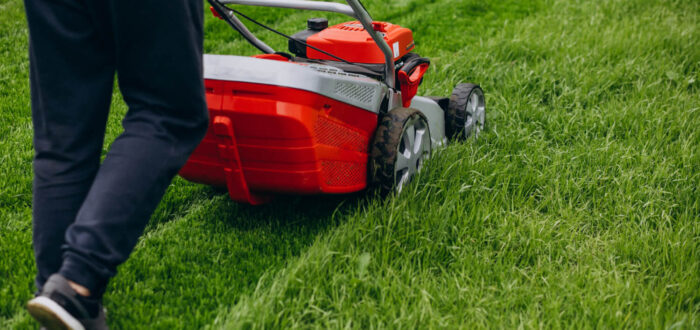A clean, sharp lawn mower blade is crucial for achieving that crisp, polished lawn look we all strive for. But over time, those blades inevitably become dull, making your grass appear frayed and torn after mowing. Learning how to properly sharpen lawn mower blades will restore peak cutting performance so you can mow with confidence again.
In this comprehensive guide, we’ll cover everything you need to know about sharpening your mower blades at home. You’ll learn the signs that tell you it’s time to sharpen, what tools to use, easy step-by-step instructions, and when to seek professional help. With just a file and a steady hand, you can extend the life of your mower blades and have them slicing through grass like new.
Why Sharpen Your Lawn Mower Blades?
Before we get into the how-to, let’s look at why sharpening is so important for the health and appearance of your lawn:
Prevent Ragged, Uneven Cuts
When mower blades are dull, instead of making clean slices through each blade of grass, they shred and tear it unevenly. This gives your lawn a frayed, brownish look after mowing. Sharpening fixes this by restoring the blades’ thin, tapered cutting edges.
Avoid Thatch Buildup
Thatch is a layer of dead and decaying grass stems and roots that accumulates if grass isn’t cut cleanly. Dull blades are more likely to cause thatch buildup by crushing grass instead of cutting it. Thatch prevents water, air and nutrients from reaching the soil.
Reduce Fuel Waste
As blades dull, the mower engine has to work harder to spin them during mowing. This wastes gas and puts unnecessary wear on the engine. Keeping blades sharp reduces engine strain and fuel consumption.
Prevent Weeds
Jagged, crushed grass tips are more vulnerable to disease, fungus and weeds. Clean cuts from sharp blades help grass stay healthy and limit weed invasions.
Improve Lawn Appearance
Most importantly, sharp mower blades simply leave your lawn looking manicured and attractive after mowing. It’s the best way to showcase a lush, green lawn you’ve worked hard to maintain all season.
When to Sharpen Lawn Mower Blades
You know keeping blades sharp is vital, but how do you know exactly when they need sharpening? Watch for these signs:
- Ragged cut quality with frayed blade tips
- Uncut patches of grass left behind
- Lots of grass clippings clumped on the lawn
- Your mower engine seeming to work harder than usual
- Excessive vibration coming from the mower deck
If you notice any of these issues, it’s definitely time to sharpen. Industry experts recommend sharpening blades at least once per year. For avid mowers, sharpening 2-3 times per mowing season gives the best cut.
DIY Lawn Mower Blade Sharpening Process
With the right tools and safety precautions, sharpening standard side-discharge mower blades is totally achievable in your own garage or workspace. Here is the complete step-by-step process:
Gather the Necessary Sharpening Tools
You’ll need:
- Flat mill file sized for your blade width (usually 8-10 inches)
- Gloves to protect your hands
- Sturdy wooden block to secure the blade
- Appropriate socket wrench for your mower’s blade bolts
- Rags for cleaning the blades
- Eye protection like safety goggles
- (Optional) Blade balancer tool
Before starting, carefully remove the lawn mower blade according to your owner’s manual instructions. Remove any caked-on grass buildup with a wire brush.
Secure the Blade Upside Down on a Block
Place a sturdy wooden block on your work surface and clamp or bolt the upside down mower blade onto it. Position the blade so the cutting edges you’ll sharpen extend just over the block edge.
Locate the Original Sharpening Bevel
Examine the blade to find the original angled bevel from the factory sharpening. Maintain this bevel angle as you manually resharpen — usually 25-35 degrees.
Steadily Sharpen the Bevel With a File
With one gloved hand on the blade opposite the sharpening edge to hold it steady, use your dominant hand to run the file at the bevel angle along the cutting surface. Apply moderate pressure moving from the blade shoulder down towards the tip.
Flip the blade over and repeat the same filing motion on the opposite cutting edge until both sides have a smooth bevel and visibly sharp edge. Take care to avoid rounding off the taper.
Refine and Polish the Edges
Carefully feel for any remaining tiny nicks, gaps or uneven spots along the cutting edges. Use extra sharpening strokes with the file to refine and polish the blade. Avoid running your bare fingers perpendicularly across the sharp edges for safety.
Balancing the Blade (Optional)
You can verify even blade weighting by placing the sharpened blade on a screwdriver point or nail. If it clearly tips to one side, additional sharpening is needed to balance it out. Or use a blade balancer tool.
Once satisfied with your sharpening job, reinstall the mower blade securely according to your mower manual’s torque specifications. You’ll be mowing with renewed cutting efficiency again in no time!
When to Call a Professional for Sharpening
While routine at-home sharpening is fine for straight, standard mower blades, certain situations call for seeking professional help:
- Bent, cracked or otherwise damaged blades. These require special repair or replacement.
- Large, heavy-duty mower blades that are difficult to file by hand.
- Persistent poor cutting performance even after sharpening. Machines can sharpen at more precise angles.
- Mulching blades or blades with complex shapes unsuited to manual sharpening.
- Zero-turn mowers with multiple blades best serviced by professionals.
For expert sharpening in these cases, contact a reputable local small engine repair shop like Greg’s Small Engine Repair. The technicians at Greg’s use top-of-the-line grinding equipment to restore damaged mower blades to like-new condition.
Finding a professional lawn mower blade sharpening service near you is fast and easy. Just search for “lawn mower blade sharpening near me” or “lawn mower blade sharpener near me” to locate Greg’s shop in your area. We guarantee you’ll be beyond satisfied with how sharply your mower blades cut after being professionally sharpened.
Don’t put up with the ragged, uneven lawn cutting that results from dull mower blades. Regular sharpening is the key to maintaining your lawn’s appearance and your mower’s performance. Follow this guide to DIY blade sharpening with a simple hand file.
Or call on the sharpening experts at Greg’s Small Engine Repair when your blades need precise professional work. Keep your mower blades in peak form this season for a lawn that earns you compliments from the neighbors!






















